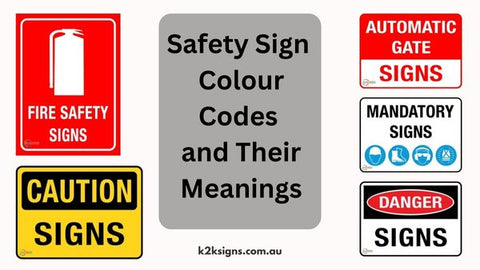Safety Sign Colour Codes and Their Meanings
Safety signs serve as silent guardians in our daily lives, guiding us through various environments and helping to prevent accidents. While the symbols and text on safety signs are essential, the colours used play an equally vital role. This blog post will explore safety sign colour codes and their meanings to understand how they convey important messages comprehensively.

The Significance of Safety Sign Colours
Colour is not arbitrary when it comes to safety signs. Colours are chosen deliberately to convey information quickly and effectively. They grab our attention and trigger an immediate response. These colour choices are not merely aesthetic preferences; they follow international standards to ensure consistency and clarity.
The use of colour in safety signage serves several critical purposes:
- Quick Recognition: Colours help people recognise the type of message a sign conveys almost instantly, without needing to read the text or study the symbol.
- Universal Understanding: Using consistent colours allows for universal understanding across language barriers. A red stop sign means the same thing in any part of the world.
- Emotional Impact: Colours evoke emotions and psychological responses. For instance, red is often associated with danger, reinforcing the need to stop or take immediate action.
Common Safety Sign Colours and Their Meanings
1. Red Signs
Red is the colour of caution and prohibition. It is typically used for prohibition signs, indicating actions or strictly off-limits areas. When you see a red sign, it means "stop" or "do not." Examples of red signs include "No Entry" signs, "No Smoking" signs, and "Stop" signs at intersections.
2. Yellow Signs
Yellow is reserved for warning signs. This vibrant colour signals caution and potential hazards ahead. When you encounter a yellow sign, it indicates that you should proceed with care. Examples of yellow signs include "Caution: Wet Floor" signs, "Warning: High Voltage" signs, and "Slippery When Wet" signs.
3. Green Signs
Green signifies safety and provides important information. When you see a green sign, it typically offers guidance on safe conditions or points the way to safety-related facilities. Examples of green signs include Emergency signs, First Aid signs, and directional signs in buildings.
4. Blue Signs
Blue is used for mandatory or informational signs. These signs indicate that you must follow specific instructions or rules and regulations. Examples include Wear Personal Protective Equipment signs, Notice Signs and Handwashing Station signs.
5. Orange Signs
Orange is commonly associated with construction and temporary signs. These signs warn of temporary conditions often found in roadwork zones, construction sites, or maintenance areas. Examples of orange signs include Construction Zone Ahead signs, Detour signs, and Temporary Roadwork signs.
6. White Signs
White is used for regulatory signs, which display laws, rules, and regulations you must follow. These signs are often used on roadways to provide essential information to drivers. Examples include "Speed Limit" signs, "Yield" signs, and Office and Building signs.
Special Cases and Exceptions
While these colour codes are generally consistent, specific industries or regions can have variations and exceptions. For example, purple is used for radiation signs, indicating the presence of ionising radiation. Brown may be used for recreational signs in some regions, such as park trail markers. Please always be aware of any unique colour codes in specialised contexts and locations.
The Role of Pictograms and Text
Colours are often supplemented with symbols or text to enhance message clarity. These additional elements further reinforce the message and make it universally understandable. For instance, a yellow Children & Kids sign may also feature a pictogram of a children playing or riding a cycle.
Conclusion
Understanding safety sign colour codes is pivotal for your safety and compliance with regulations. These colours are not chosen randomly; they are meticulously selected to convey vital information quickly and effectively. The next time you encounter a safety sign, you can just take a moment to consider its colour, and you'll have a better grasp of the message it's sending.
Remember, safety is everyone's responsibility, and being aware of safety signs, including their colours and meanings, is a simple yet powerful way to contribute to a safer environment.

